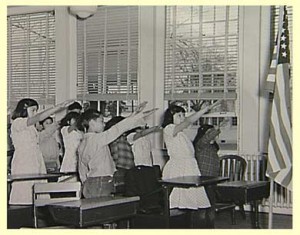The United States Pledge of Allegiance was written in 1892 by an American socialist named Francis Julius Bellamy, who was also a Baptist minister, and whose cousin Edward Bellamy is the semi-famous author of two socialist utopian novels: Looking Backward (1888) and Equality (1897).
Francis Bellamy was born in Rome, New York, May 18, 1855. He died August 28, 1931. His original Pledge of Allegiance was first published in a magazine called Youth’s Companion, a nationally circulated publication written for youngsters.
In 1888, Youth’s Companion began its campaign to sell American flags to public schools. For Francis Bellamy, this was more than a mere money-maker: it was an opportunity for him to spread his statist propaganda, and in the end Youth’s Companion became a supporter of the Schoolhouse Flag Project, which, under Bellamy’s watchful eye, aimed to place a flag above every public school in America.
His Pledge of Allegiance was first published in the September 8th (1892) issue of Youth’s Companion.
Along with the Pledge, the children were asked to perform the so-called Bellamy Salute (photo below).
Not four decades later, when the Nazi’s rose to power and began saluting in a similar manner, Franklin Roosevelt changed the salute to the hand-over-heart method we see today.
Francis Bellamy’s original Pledge of Allegiance, the recitation of which he intended to take no more than 15 seconds, went like so:
I pledge allegiance to my Flag and to the Republic for which it stands, one nation indivisible, with liberty and justice for all.
Here, in Bellamy’s own words, is why he chose the specific language that he chose for his Pledge:
It began as an intensive communing with salient points of our national history, from the Declaration of Independence onwards; with the makings of the Constitution … with the meaning of the Civil War; with the aspiration of the people…
The true reason for allegiance to the Flag is the ‘republic for which it stands’. …And what does that vast thing, the Republic mean? It is the concise political word for the Nation – the One Nation which the Civil War was fought to prove. To make that One Nation idea clear, we must specify that it is indivisible, as Webster and Lincoln used to repeat in their great speeches. And its future?
Just here arose the temptation of the historic slogan of the French Revolution which meant so much to Jefferson and his friends, ‘Liberty, equality, fraternity’. No, that would be too fanciful, too many thousands of years off in realization. But we as a nation do stand square on the doctrine of liberty and justice for all…
The phrase under God was incorporated into the Pledge on June 14, 1954. The man to introduce it was a fellow named Louis A. Bowman (1872-1959).
Here are the transmutations that the Pledge has undergone since its inception in 1892:
1892
“I pledge allegiance to my flag and the republic for which it stands: one nation indivisible with liberty and justice for all.”1892 to 1923
“I pledge allegiance to my flag and to the republic for which it stands: one nation indivisible with liberty and justice for all.”1923 to 1924
“I pledge allegiance to the flag of the United States and to the republic for which it stands: one nation indivisible with liberty and justice for all.”1924 to 1954
“I pledge allegiance to the flag of the United States of America, and to the republic for which it stands; one nation indivisible with liberty and justice for all.”1954 to Present
“I pledge allegiance to the flag of the United States of America and to the republic for which it stands: one nation under God, indivisible, with liberty and justice for all.”

The problem, of course, with all this indivisibility talk is that the states were not necessarily intended to be indivisible. As Thomas Jefferson said:
If any state in the Union will declare that it prefers separation … to a continuance in union, I have no hesitation in saying, “let us separate” (Thomas Jefferson, 1816).
And John Quincy Adams — a devoted unionist — noted in a 1839 speech about secession:
[In] dissolving that which can no longer bind, we would have to leave the separated parts to be reunited by the law of political gravitation to the center.
If, then, you’ve ever wondered why it is when you hear the Pledge of Allegiance you feel as if you’re hearing the intonations of brainwashed drones, this is why:
The Pledge was a propaganda prayer written by a socialist who’s goal was to inculcate young minds with dogma.
And that’s the end of it.
Author’s Note: This article first appeared January 1st, 2010, on this website.

